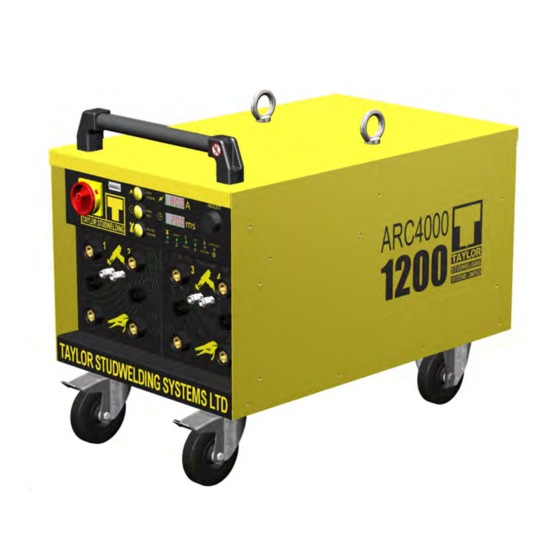Summarization of Contents
Useful Information
Manufacturers Contact Details
Company contact information including phone, fax, email, and web address for technical support.
Guide Purpose and Scope
Outlines the manual's objective, intended users, and the range of topics covered within the operating guide.
Additional Information and Precautions
Provides further contact points and emphasizes careful reading of the manual before operating the equipment.
Important Safety Information
Personal Protection and Awareness
General instruction to thoroughly read and understand all safety notes prior to operating the welding equipment.
Electrical Hazard Precautions
Warns about electrical dangers and mandates power disconnection before any maintenance tasks are performed.
Fire Risk Management
Alerts users to the possibility of fire hazards arising from hot metal expulsion during the welding process.
Personnel Safety Measures
Details protective actions for eyes, ears, and body against arc rays, fumes, and magnetic field exposure.
Maintenance Safety Checks
Stresses the importance of inspecting cables for wear or damage to prevent electrical hazards during maintenance.
Operator Training Requirement
Mandates that only authorized personnel who have completed the necessary training should operate the equipment.
Safe Installation Practices
Provides guidance for safe equipment installation, preventing risks like dropping or cable damage from external forces.
Electromagnetic Interference
Addresses the potential for electromagnetic interference generated by the equipment during its operation.
Proper Equipment Disposal
Offers recommendations for the environmentally responsible disposal of the equipment and its constituent parts.
Introduction to Studwelding
Overview of the Studwelding Process
Explains the fundamental sequence of operations in the drawn arc studwelding procedure.
Guide to External Features
Front Panel Component Identification
Identifies and lists the various controls, indicators, and connectors on the front panel of the welding unit.
Control Panel Functionality
Details the purpose and operation of each element, indicator, and display on the main control panel.
Back Panel Component Identification
Identifies and lists the components and connection points located on the rear panel of the welding unit.
Setting Up and Welding
Pistol Selection and Activation
Provides instructions for selecting and activating a specific welding pistol on the controller unit.
Weld Current Adjustment
Details the procedure for setting the desired weld current using the controller's adjustment knob and display.
Weld Time Configuration
Explains how to set the weld time parameter via the controller's adjustment knob and digital display.
Shielding Gas Purge Setting
Guides the user on setting the duration for the shielding gas purge function within the controller.
Visual Weld Inspection
Ceramic Ferrule Weld Quality Assessment
Describes how to recognize a properly formed weld and common issues when using ceramic ferrules.
Weld Inspection: Insufficient Heat/Time
Addresses problems from low heat or time, leading to incomplete welds and poor fillet formation.
Weld Inspection: Excessive Heat/Time
Details issues caused by excessive heat or time, resulting in messy welds and splatter.
Weld Inspection: Ferrule/Stud Fitment
Covers problems related to improper ferrule seating or the stud binding against the ferrule.
Weld Inspection: Stud Protrusion
Discusses insufficient stud protrusion and the correct method for adjustment and correction.
Weld Inspection: Stud Alignment
Addresses issues of poor stud alignment relative to the workpiece during the welding process.
Weld Testing
Destructive Weld Testing Procedures
Outlines methods for performing destructive tests on welds, such as hammer impact tests.
Non-Destructive Weld Testing Methods
Focuses on non-destructive testing techniques, specifically emphasizing torque testing of welds.
Studwelding Techniques
Horizontal Welding Technique
Details the procedure for welding studs onto a plate in a horizontal orientation.
Overhead Welding Technique
Explains the method for welding studs to a plate when working in an overhead position.
Pistol Handling in Vertical/Overhead Welding
Addresses potential difficulties and solutions for pistol operation in vertical or overhead welding scenarios.
Long Cable Welding Considerations
Provides guidance on the use of extended welding cables and their impact on the welding process.
Welding Short Studs with Ferrules
Describes techniques for welding studs shorter than 25mm using appropriate ferrule types.
Positional Accuracy with Templates
Explains how to use templates effectively to ensure precise stud placement during welding operations.
Minimum Plate Thickness Recommendations
Specifies the minimum recommended thicknesses for plates when performing stud welding.
Stainless Steel Welding Specifics
Covers particular techniques and considerations relevant to welding stainless steel studs.
Welding Near Obstructions
Details methods for welding studs in proximity to corners, flanges, and other physical obstructions.





Need help?
Do you have a question about the Acoustic 4 and is the answer not in the manual?
Questions and answers